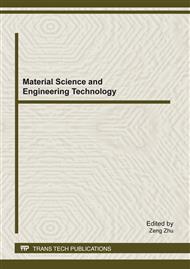[7]
Since the switching frequency much larger than the grid frequency, we assume the input and output voltages are constant in a switch cycle. Therefore, when boost circuit continuous conduction, we can predictive the slope of inductor current with switch turns off during switch turns on. So we can get switching modulation control predict equations expression.
Google Scholar
[7]
(2) Where:V0—load voltage;D-duty cycle;Ts-sampling period. (a)Relationship of and of PACC (b)One switching cycle of PACC Fig. 1 Relationship of and of PACC Figure 1 shows, the average inductor current than average inductor current function large in each switching cycle. According to control objectives of the average inductor current with the average inductor current function are same, To make the two equal, we control equation (2) amended to expression (3). (3) Equation (3) is a new control strategy used in this paper, that is, the predictive average current control. When the BOOST converter in continuous conduction mode, we get: (4) Equation(4) into the equation (3) can be predicted average current control strategy of the carrier function expression. (5) Fig. 2 The schematic diagram of the PFC Boost with PACC Based on the above analysis, the average current control can be drawn predict single-phase PFC BOOST PFC control block diagram shown in Figure 2 Simulation research To verify the predicted average current control PFC Boost Converter correctness, the predicted average current control strategy is studied with Matlab simulation software and simulink toolbox in this paper. Simulation model shown in Figure 3. Due to limited space, the simulation model did not give the sub-module. Simulation parameters: AC power source Vs is 220V;AC power frequency is 50Hz;IGBT switching frequency is 50kHZ;Output voltage is 400V;Load resistance R is 450Ω;Smoothing inductor L1 is 2. 5mH;Output filter capacitor C is 470uF. Separated voltage resistance of Detection the output voltage R1 and R2 are 1580kΩ and 20kΩ;Current sampling resistor Rs is 0. 02Ω. Figure 4 shows the AC side voltage and current simulation waveforms; Figure 5 shows the spectral content of the input current waveform; Figure 6 shows the DC voltage Udc voltage waveforms. Fig. 3 Simulation model Fig. 4 Simulation waveforms of input voltage and current Fig. 5 Simulation waveform of Udc Fig. 6 The frequency spectrum of input current It can be seen from the simulation waveform, when the system normal operation, the AC side voltage and current phase is basically the same, indicating that the converter can achieve unity power factor operation, and current waveforms are approximately sinusoidal (harmonic distortion THD is 3. 46%), indicating that the AC side current harmonics is very small, fully able to meet power requirements. Conclusion This paper introduce a novel predicted average current PFC Boost converter control strategy, its control principle of a detailed analysis, simulation research indicate that the predicted average current control PFC Boost converter with a control circuit is simple and reliable, the input high power factor, current harmonic distortion, anti-interference ability, etc., for the active power factor correction provides a simple and practical control methods. Acknowledgment Thanks National Science Foundation of China and Award Number (51167009). Referrence.
Google Scholar
[1]
M. Nakamura, Y. Fujitani and S. Kawauchi, Several Recent Circuits in the Small Power UPS System, National Convention Record, IEE IAS Japan (JIASC), vol. 2, No. S-1-2-2, (1995).
Google Scholar
[2]
Keyue M. Semdley, Sloboan Cuk. One-cycle control of switching converters [ J ]. IEEE T ran s on Power Electronics, 1995, 10( 6): 6252633.
Google Scholar
[3]
Yu Rongrong, Wei Xueye, Wu Xiaojin, Tan Qingnu. An Improved Predictive Current Control Algorithm[J], Transactions of China Electrotechnical Society, 2010,Vol25(7): 100-107.
Google Scholar
[4]
Xiao Wenxun, Zang Bo, Qiu Dongyuan. Improved Automatic Current-sharing Control Based on Average Current Mode for Parallel Boost Converters[J], Proceedings of the CSEE. 2007, Vol27(13): 64-69.
Google Scholar
[5]
Zeng Qinghong, Yang Shijie. An Active Power Factor Correction Technique Based on Average Current Control[J], Journal of Zhengzhou University(Engineering Science), 2006, Vol24(1): 72-74(90).
Google Scholar
[6]
Pu Xifeng, Wang Honghua. Modeling and Simulation of PFC Boost Converter Controlled by One-Cycle Algorithm Based on MATLAB[J],. Machine Building & Automation, 2007, Vol, 36(6): 145-147(160).
Google Scholar
[7]
Hu Xueqiong. Study on Single Phase Active Power Factor Correction Converter of Predictive Averaged Current Mode Control[D], Chongqing City, Chongqing University, 2007. 4, pp: 27-30.
Google Scholar
[8]
Mehdi Ferdowsi, Zhong Nie, Ali Emadi. A new estimative current mode control technique forDC-DC converters operating in discontinuous conduction mode[C]". Power Electronics and Motion Control Conference, IPEMC, 04. pp: 497-501.
DOI: 10.1109/lpel.2004.830245
Google Scholar
[9]
P. Shanker, J.M.S. Kim. A new current programming technique using predictive control[C]". Telecommunications Energy Conference, INTELEC, 94 pp: 428-434.
DOI: 10.1109/intlec.1994.396633
Google Scholar
[10]
Jonathan M. S, Kim Pankaj Shanker, Wei Zhang. Analysis of predictive control for active power factor correction" . Industrial Electronics, Control and Instrumentation, IECON, 94 pp: 446-451.
DOI: 10.1109/iecon.1994.397819
Google Scholar
[11]
Wanfeng Zhang, Guang Feng, Yan-Fei Liu. A new predictive control strategy for power factor Correction, . Applied Power Electronics Conference and Exposition, APEC03 pp: 403-409.
DOI: 10.1109/apec.2003.1179245
Google Scholar
[12]
Rodriguez J, et al. Predictive current control of a voltage source inverter[J]. IEEE Transactions on Industry Electronics, 2007, 54(1): 495-503.
Google Scholar
[13]
Athalye P, Maksimovie D, Erickson R. Variablefrequency predictive digital current mode control[J]. IEEE Power Electronics Letters, 2004, 2(4): 113-116.
DOI: 10.1109/lpel.2004.841493
Google Scholar
[14]
Holmes D G, Martin D A. Implementation of a direct digital predictive current controller for single and three phase voltage source inverter [C]. Proc. Annu. Meeting IEEE, 1996: 906-913.
DOI: 10.1109/ias.1996.560191
Google Scholar


